-
WANTED: Happy members who like to discuss audio and other topics related to our interest. Desire to learn and share knowledge of science required. There are many reviews of audio hardware and expert members to help answer your questions. Click here to have your audio equipment measured for free!
You are using an out of date browser. It may not display this or other websites correctly.
You should upgrade or use an alternative browser.
You should upgrade or use an alternative browser.
Simulation Overview of the 'Double Bass Array' Configuration.
- Thread starter René - Acculution.com
- Start date
Pseudo-coaxial with narrow directivity (and Horbach-Keele filters)
*UPDATE*: Here is now my final build. :) I want to show you my prototype of a pseudo-coaxial design. It is the 10th of its kind. It is not easy to achieve a constant directivity that is narrow at the same time. It took me months to get the directivity like it is. And it still could be...
This makes me wonder if a Horbach-Keele array...
...Could be wall-mounted such that the subwoofers in the array form an SBA (or DBA with another set of identical subwoofers on the rear wall).
Even if a 1/4 wall width location is suitable - the centers will be too high for a seated listener. You may see effects of inaccurate positioning in RoomSim, quite a useful result can be obtained at low frequencies.Horbach-Keele array...
Even if a 1/4 wall width location is suitable - the centers will be too high for a seated listener. You may see effects of inaccurate positioning in RoomSim, quite a useful result can be obtained at low frequencies.
Well, if one were willing to entertain something as esoteric as a DBA or Horbach-Keele array, surely a high chair is a trifle...
Just thought that the concepts had some affinity with each other and could theoretically work together.
And could practically work together. With some decrease in the DBA effect. Also, some correction of the wave front is possible.could theoretically work together
I disagree, both *BA and HKA are absolutely rational))esoteric as
Coming late into this thread.  Promoted to home page.
Promoted to home page.
got one sub and positioned it on the wall behind listening spot as it was practical place for it. Couldn't measure the system yet but set levels by ear to fullrange mains and response was notably uneven at listening position. Then, as both mains and the sub are effectively at the wall I adjusted delay for the sub to room length, and if feels much more even response.Nope, never heard such thing, participating on the discussion as its interesting topic. I was reading Griesingers papers on proximity and if there is anything on small room acoustics and stumbled on the envelopment, which is something i'd like to improve on my setup as well. Surprisingly low frequencies seem to be involved and DBA topic came to my mind.
Even multisub setups are rare as hens teeth here. I plan for multisub setup in the future, but cannot do whole wall covering arrays as its family living room
So, anyone wondering about the DBA just try it with what ever you have, takes 5 minutes if you have a sub and means to add delay. Even though it doesn't get to the performance possible with DBA I'd say it was heck of a quick "integration" and seems to work better than hoped
A song from a great album to test lows
Last edited:
Quick observation, perhaps obvious to many: if a DBA system works in a room so that it eliminates modes affecting sound this means one would lose both the dips and ~10db peaks. Losing the "apparent boost" of lows makes the lows appear quieter of course. Basically woofers on the front need to have enough volume displacement to reach desired SPL and bandwidth without any help from the room which makes another reason DBA a job for multiple subs. For serious system 4 LF sources on the front, at least. To get an idea take your current traditional setup sub outside, against a wall but otherwise open space, and try if it has enough capability to be impressive or would you like mo? 
Last edited:
I've no experience with DBA but I create and apply digital VBA (virtual bass array) filters frequently and I thought this might be relevant. A VBA filter is a precisely time aligned polarity inverted Dirac pulse to counter act the room standing waves. I have experienced that rather than focusing only on one room dimension (length), it performs better if room resonant frequency is calculated by using all three dimensions (L,W,H) from the formula f = c / (2 x ( L+W+H)). For the particular dimensions (5,4,3 meters) chosen by the OP at the begining of this topic, the resonant frequency will be 14.29Hz which will be the first dip. Peaks and dips will follow in its harmonics:Quick observation, perhaps obvious to many: if a DBA system works in a room so that it eliminates modes affecting sound this means one would lose both the dips and ~10db peaks. Losing the "apparent boost" of lows makes the lows appear quieter of course. Basically woofers on the front need to have enough volume displacement to reach desired SPL and bandwidth without any help from the room which makes another reason DBA a job for multiple subs. For serious system 4 LF sources on the front, at least. To get an idea take your current traditional setup sub outside, against a wall but otherwise open space, and try if it has enough capability to be impressive or would you like mo?
A polarity inverted Dirac pulse delayed by 1 / (2 x 14.29) = 0.03489 seconds will cancel these peaks and nulls.
Actual FR graphs before (yellow) and after (dark blue) such a filter (light blue) is applied in my room with slightly different dimensions (the inverted pulse has a lowpass filter starting at the 3rd dip):
I apologize for potentially veering off topic, but I'd think it's fair to say that the filter actually "boosts" the speaker bass below the first peak by cancelling the first null at around 15Hz. Along with the improvements in the nulls following, the effect in bass is a very audible fullness in the overall bass response.
Due to the timing in the design, it's neither a minimum nor a linear phase filter but a "maximum phase" filter and introduces a fixed group delay. So the bass is not as "fast" as it were and that's about the only negative thing I can say about it.
withoutsuit
Active Member
- Joined
- Dec 21, 2021
- Messages
- 163
- Likes
- 97
Minor correction: DBA affects the reverberation time at the first instance, effects on the frequency response are there (as the spl of the frequency is also related to reverberation / kind of partly dependent) but the main effect is on reverberation. So when configuring an DBA you should have a look at the waterfall / spectogramm rather then the frequency response. "Peaks" with low reverberation are far less harmfull, than a high reverberation and easly be EQed.Quick observation, perhaps obvious to many: if a DBA system works in a room so that it eliminates modes affecting sound this means one would lose both the dips and ~10db peaks. Losing the "apparent boost" of lows makes the lows appear quieter of course. Basically woofers on the front need to have enough volume displacement to reach desired SPL and bandwidth without any help from the room which makes another reason DBA a job for multiple subs. For serious system 4 LF sources on the front, at least. To get an idea take your current traditional setup sub outside, against a wall but otherwise open space, and try if it has enough capability to be impressive or would you like mo?
@OCA nice to read you - I´m Paul, we´ve just corresponded below one of your youtubevideos.
Hi,Minor correction: DBA affects the reverberation time at the first instance, effects on the frequency response are there (as the spl of the frequency is also related to reverberation / kind of partly dependent) but the main effect is on reverberation. So when configuring an DBA you should have a look at the waterfall / spectogramm rather then the frequency response. "Peaks" with low reverberation are far less harmfull, than a high reverberation and easly be EQed.
@OCA nice to read you - I´m Paul, we´ve just corresponded below one of your youtubevideos.
I think I see what you mean. I'll expand on it quickly as thinking reverberation makes interesting thought experiment and connecting the theoretical system to reality.
Ideally, outside or in a plane wave tube frequency response of a subwoofer is like in WINISD, since the woofers are pistonic at low frequency and as such as close to ideal simulator situation as possible. Thus, any peaks and dips in room response are either sound interfering with the box or with the room. Since wavelengths are long effects of box are at high frequency, unless the box is size of the room. Peaks and dips occur as the sound reflects from boundaries and interfere either with direct sound and/or with other reflections. I guess with reverberation you note the standing waves emerging, which I think is all that is left after a while, standing waves "reverberate" longer than any other reflections. Hence resulting peaks and dips in frequency response, depending on where the source(s) are and where the listener is.
I'm not sure which is more easily observed, peaks/dips in bass response or long reverberation, perhaps they both contribute to same perceived sound phenomenon what I know as uneven bass: some bass notes on a song seem crazy hot while some seem weak, almost inaudible. Run a low frequency sweep and you notice the amplitude modulation which corresponds to the standing waves mostly, I think. I bet there is various ways to detect and measure and compare. Perhaps waterfall plot is nice. Its quite easy to hear ~20db amplitude variation on a sweep though, and it shows in frequency response already, and traceable back to physical dimensions of the room.
edit: its hard to relate perceived sound to visual / text stuff on forums / papers, reflections and sustained notes, delays, so on. Its really very different domain that visuals where we have strong notion of time in a way that most daily interaction happens in realtime, we see objects moving, where they are located and so on. Sound is not visible though, and its quite fast, even though it is quite slow compared to light
Reasoning about DBA: its ideal subwoofer system, but what happens when the mains speakers are introduced? They probably crossover at frequency which is still in modal region, so they would trigger modes. Perhaps the result is not as lumpy as without the DBA though.
Last edited:
- Joined
- May 1, 2021
- Messages
- 427
- Likes
- 1,302
- Thread Starter
- #72
I can try and simulate that.Reasoning about DBA: its ideal subwoofer system, but what happens when the mains speakers are introduced? They probably crossover at frequency which is still in modal region, so they would trigger modes. Perhaps the result is not as lumpy as without the DBA though.
withoutsuit
Active Member
- Joined
- Dec 21, 2021
- Messages
- 163
- Likes
- 97
The DBA is aligned with the fronts as "one subwoofer". So you configure your DBA first and then crossover it to the mains. Roughly said, adding more subs lead to increased effectiveness in rising frequencies (e.g. comparing 2 subs in front and 2 subs at rear to 4 subs at front and 4 at rear). For example my crossover to the mains is at 100 Hz although I only use 4 subs, which looses their effectivenes roughly at 70hz (but are still better, than only mains; another advantage: you avoid also SBIR-Effects of the mains in this region, as the subs are directly placed at the walls).Reasoning about DBA: its ideal subwoofer system, but what happens when the mains speakers are introduced? They probably crossover at frequency which is still in modal region, so they would trigger modes. Perhaps the result is not as lumpy as without the DBA though.
Hi,
yeah I would think so as well, best handled as one unit.
I think problem is the low frequencies of mains are not compensated. I mean, lets imagine we have DBA setup in perfectly working order, no hints of standing waves, just pristine bass. As the sub system handles itself regardless of mains we can now abstract it away and inspect / imagine the mains alone and how they interact with the room. Mains high passed at 100Hz would excite the modes normally around the 100Hz, if they do not make a plane wave and are cancelled at back of the room. To circumvent on would have to make the plane wave up to schroeder frequency I guess, 16 sources per wall? now the furnishing and all would affect how it works I believe, unreachable.
SBIR is nasty, affects mainly above 100Hz, unless speaker is ~1m out from the wall, which is the most usually recommended distance. All first reflections combined, in general, tend to make huge dip >100Hz. Luckily the first reflections are gone in milliseconds and many more come in and compensate
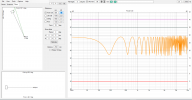
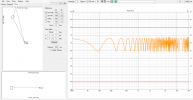
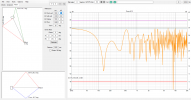
I believe you the bass array gives some relief on this, but would reason it doesn't eliminate SBIR effects from graphs, perhaps helps with audibility and thats all we need.
After all, its impossible to get anything "ideal". Its fun to imagine the stuff on the ideal perspective though
edit.
here sim of ideal mains speaker 1m away from wall, same as middle picture above. Then two ideal subs on the wall behind to emulate half of a bass array is added. Without delay on the mains the problem is still there. With delay its easier, but a power response dip occurs and it's basically still there. To remove SBIR we'd need to prevent sound from mains reflect from the wall, cancel it with the subs. So actually the subs would need to be delayed, polarity flipped and so on, which wouldn't still help as the overlapping bandwidth is so small, so we need to get mains further from the wall to get SBIR lower in frequency and leave the high pass out, and now we excite the modes and so on. Mo problems. Perhaps FIR precondition filter could help, remember to add to back woofers as well perhaps easier to embed the main speakers into the front wall as well, than go this route. Make the whole front wall a speaker, plane wave all the way up to schroeder. Problem with this is that plane wave is mono.
perhaps easier to embed the main speakers into the front wall as well, than go this route. Make the whole front wall a speaker, plane wave all the way up to schroeder. Problem with this is that plane wave is mono.
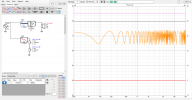
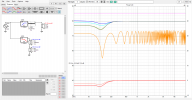
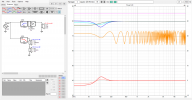
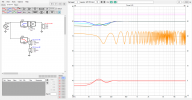
How about making the front (and back) wall perhaps 8 full height line arrays of say 3" full range drivers? make plane wave as high frequency as ear tells, then shade away the rest.. well or just go outside to a field when in need of pristine sound
yeah I would think so as well, best handled as one unit.
I think problem is the low frequencies of mains are not compensated. I mean, lets imagine we have DBA setup in perfectly working order, no hints of standing waves, just pristine bass. As the sub system handles itself regardless of mains we can now abstract it away and inspect / imagine the mains alone and how they interact with the room. Mains high passed at 100Hz would excite the modes normally around the 100Hz, if they do not make a plane wave and are cancelled at back of the room. To circumvent on would have to make the plane wave up to schroeder frequency I guess, 16 sources per wall? now the furnishing and all would affect how it works I believe, unreachable.
SBIR is nasty, affects mainly above 100Hz, unless speaker is ~1m out from the wall, which is the most usually recommended distance. All first reflections combined, in general, tend to make huge dip >100Hz. Luckily the first reflections are gone in milliseconds and many more come in and compensate



I believe you the bass array gives some relief on this, but would reason it doesn't eliminate SBIR effects from graphs, perhaps helps with audibility and thats all we need.
After all, its impossible to get anything "ideal". Its fun to imagine the stuff on the ideal perspective though
edit.
here sim of ideal mains speaker 1m away from wall, same as middle picture above. Then two ideal subs on the wall behind to emulate half of a bass array is added. Without delay on the mains the problem is still there. With delay its easier, but a power response dip occurs and it's basically still there. To remove SBIR we'd need to prevent sound from mains reflect from the wall, cancel it with the subs. So actually the subs would need to be delayed, polarity flipped and so on, which wouldn't still help as the overlapping bandwidth is so small, so we need to get mains further from the wall to get SBIR lower in frequency and leave the high pass out, and now we excite the modes and so on. Mo problems. Perhaps FIR precondition filter could help, remember to add to back woofers as well




How about making the front (and back) wall perhaps 8 full height line arrays of say 3" full range drivers? make plane wave as high frequency as ear tells, then shade away the rest.. well or just go outside to a field when in need of pristine sound
Last edited:
I've been reading up on bass arrays the last few weeks. For indoors home listening the concept of exploiting a "plane wave" seems very good. Unfortunately for me and my current PC room layout I cannot have anything useful on my back wall, so the excludes double bass array (subs on the back wall) and single bass array (I cannot have thick enough sound deadening on the back wall). So I've just started dabbling with virtual bass array like previously discussed in this thread, and practical applications have been briefly discussed here: Room equalization through inverse delayed and attenuated bass signals.
In that thread OCA links a video showing a method using a custom impulse response and convolution to output the delayed cancellation signal. I also hypothesised a method that would duplicate the sound signal, then you would delay and filter the signal as required for the cancellation effect, and then merge that signal back in. Whilst I haven't tried it, I recently came across another user doing basically the same thing, which suggests it can work. Doing this method with a single subwoofer would probably work best with it in the middle of the front wall?
Also lately I happen to have been watching some vids on bass simulation for concerts etc (in open air spaces), and how the pro scene has simulation software for the task, like I briefly discussed here. This has shown that there are a few different ways to arrange 2 subwoofers so that they project more bass forward than they do backward, which sounds sort of like the basics of a plane wave. So the 3 arrangements I've noticed so far are (and I hope this is what they are called);
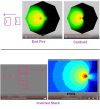
So yer, some interesting arrangements there. 2 subs in a line isn't particularly practical for small rooms, whereas 2 on top of each other is. And if getting the subs near the middle of the room vertically is important, then stacking has a natural advantage.
It seems the defining feature of the virtual/pseudo bass array is the delayed cancellation signal coming from the source driver, but with these 2 subwoofer arrangements there is a bit more choice, because the signal could be output from the front or rear subwoofer, or both. Perhaps even the original signal could be output cordioid style, and after processing the cancellation signal could be output end fire style? And one other possibility I thought of is simply adding a third subwoofer to the inverted stack, solely for outputting the delayed cancellation signal - how would that go?! Because one thing about the VBA methods mentioned previously (convolution method or copying in a second signal method), both suggest the subwoofer needs to output even more frequencies at one time than it would just normally playing the song, which might cause a problem with "dynamics"? Or possibly when adding the cancellation signal to the live signal it just cancels the signal all together, and then the speaker does nothing, and thus the in room signal doesn't get actively cancelled at all and just keeps decaying as usual?
So there is much to think about. Before starting to write this post I spent a few minutes in REW Room Calc for 2 "stacked" subwoofers, and it seems plausible. Here's my actual room and listening position (and these are without a cancellation signal factored in);
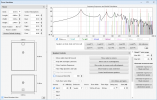
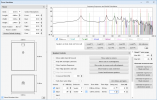
It has gone from ~108dB at ~43Hz (which is room length peak) and ~88dB at 60Hz, for a 20dB difference
estimate down to ~90dB at ~43Hz peak .............................................. and ~74dB at 60Hz, for a 16dB difference (and 75dB is the target in REW Room Sim, so whilst the peak to valley difference isn't remarkebly better, the overall room gain seems more controlled).
Or I just now came up with this one using delay, and both 43Hz and 60Hz are flat at 79dB!
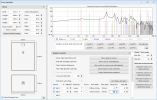
In that thread OCA links a video showing a method using a custom impulse response and convolution to output the delayed cancellation signal. I also hypothesised a method that would duplicate the sound signal, then you would delay and filter the signal as required for the cancellation effect, and then merge that signal back in. Whilst I haven't tried it, I recently came across another user doing basically the same thing, which suggests it can work. Doing this method with a single subwoofer would probably work best with it in the middle of the front wall?
Also lately I happen to have been watching some vids on bass simulation for concerts etc (in open air spaces), and how the pro scene has simulation software for the task, like I briefly discussed here. This has shown that there are a few different ways to arrange 2 subwoofers so that they project more bass forward than they do backward, which sounds sort of like the basics of a plane wave. So the 3 arrangements I've noticed so far are (and I hope this is what they are called);
- End Fire - where there is 2 subs in a line, and the rear sub is delayed. This helps project more sound forward, but you still get a fair bit at the back. I think they said the affect is quite consistent across all frequencies.
- Cordioid - still 2 subs in line, but the rear sub is polarity inverted and delayed, which has ends up giving and even better front vs rear projection ratio. Again I think the effect is quite consistent across frequencies.
- Inverted Stack - here the subs are on top of each other, one firing forward, and the other backward. The front vs rear isn't as good as cordioid, and also apparently it is quite frequency dependant based upon the distance between drivers.

So yer, some interesting arrangements there. 2 subs in a line isn't particularly practical for small rooms, whereas 2 on top of each other is. And if getting the subs near the middle of the room vertically is important, then stacking has a natural advantage.
It seems the defining feature of the virtual/pseudo bass array is the delayed cancellation signal coming from the source driver, but with these 2 subwoofer arrangements there is a bit more choice, because the signal could be output from the front or rear subwoofer, or both. Perhaps even the original signal could be output cordioid style, and after processing the cancellation signal could be output end fire style? And one other possibility I thought of is simply adding a third subwoofer to the inverted stack, solely for outputting the delayed cancellation signal - how would that go?! Because one thing about the VBA methods mentioned previously (convolution method or copying in a second signal method), both suggest the subwoofer needs to output even more frequencies at one time than it would just normally playing the song, which might cause a problem with "dynamics"? Or possibly when adding the cancellation signal to the live signal it just cancels the signal all together, and then the speaker does nothing, and thus the in room signal doesn't get actively cancelled at all and just keeps decaying as usual?
So there is much to think about. Before starting to write this post I spent a few minutes in REW Room Calc for 2 "stacked" subwoofers, and it seems plausible. Here's my actual room and listening position (and these are without a cancellation signal factored in);


It has gone from ~108dB at ~43Hz (which is room length peak) and ~88dB at 60Hz, for a 20dB difference
estimate down to ~90dB at ~43Hz peak .............................................. and ~74dB at 60Hz, for a 16dB difference (and 75dB is the target in REW Room Sim, so whilst the peak to valley difference isn't remarkebly better, the overall room gain seems more controlled).
Or I just now came up with this one using delay, and both 43Hz and 60Hz are flat at 79dB!

Last edited:
I've been pondering this topic some more and need some clarification on what is happing at the back wall. The animation seems to show the wave "disappearing" at the back wall, but perhaps it is only showing the "audible wave"? The distinction would be if the back wall subwoofers actually remove the energy from the from the room, or if they just output a tone over the top that audibly cancels the reflection. Because the following image from the Wikipedia article on Double bass array shows it is an overlapping cancellation wave.one way to achieve a propagating plane wave is to excite both the front wall and the rear wall in a pistonic-like fashion as shown in the animation below.

- Joined
- May 1, 2021
- Messages
- 427
- Likes
- 1,302
- Thread Starter
- #77
Superposition holds so you can think of it in different ways with the same end result. The Wikipedia page shows how the reflected wave is countered by the rear wall vibration. Or that it moves in a way so that it acts as a sink to the source from the front wall giving only the propagating wave part from the front vibration. I should add an animation that shows the transient behaviour also but haven’t had time.
Ultimately I was wondering what happens if that subs aren't on the wall, like in the image below? Are they actually "absorbing", or are they just "countering"?Superposition holds so you can think of it in different ways with the same end result. The Wikipedia page shows how the reflected wave is countered by the rear wall vibration. Or that it moves in a way so that it acts as a sink to the source from the front wall giving only the propagating wave part from the front vibration. I should add an animation that shows the transient behaviour also but haven’t had time.
- Joined
- May 1, 2021
- Messages
- 427
- Likes
- 1,302
- Thread Starter
- #79
This probably works to, at least steady state, but whether you think of it as absorbing or counteracting does not matter much. If the reflected wave at your listening position is gone then the room could also be open at the rear and you would get the same field (with some caveat not important for now).Ultimately I was wondering what happens if that subs aren't on the wall, like in the image below? Are they actually "absorbing", or are they just "countering"?
View attachment 305516
IMO this will not work
Similar threads
- Replies
- 69
- Views
- 5K
- Replies
- 4
- Views
- 539
- Replies
- 4
- Views
- 539
- Replies
- 26
- Views
- 2K
